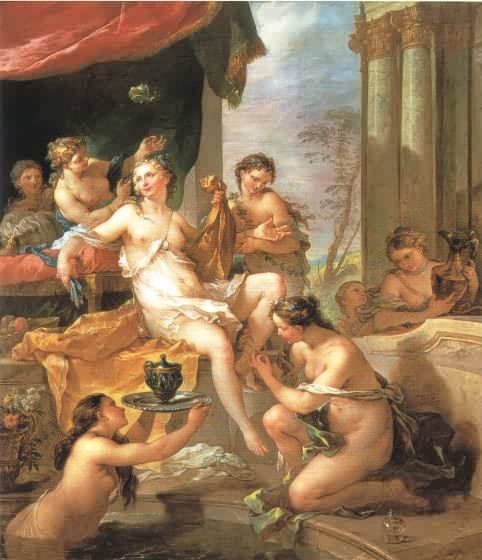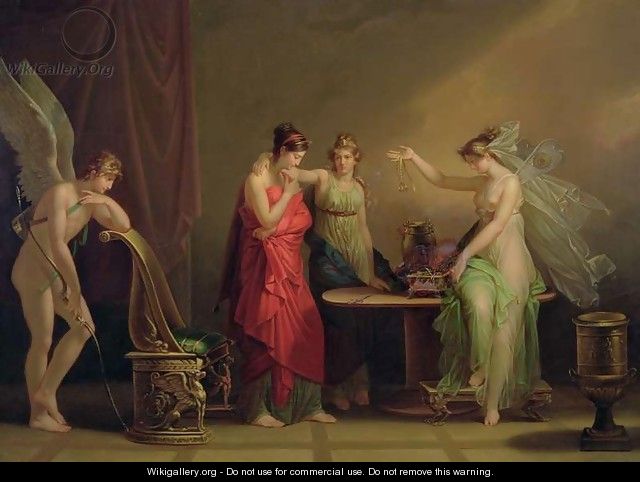The Myth
The story of Cupid (or Eros) and Psyche is one of the most romantic from mythology. The myth tells of a girl so beautiful that men began to abandon the temples of Venus to worship her, sending the goddess into a rage. She sent her son to Psyche in order to destroy the girl by having her fall in love with a monster, not knowing he would fall in love with her himself. He took the girl to his palace as his wife, only visiting her at night and never allowing her to see him. When poor Psyche's jealous sisters poisoned her mind with horrors about her husband she glanced upon his sleeping form with the help of an oil lamp which promptly dripped and wounded him, causing him to abandon her, for 'there can be no love where there is no trust.' She then was forced to go through a series of impossible tasks by Venus in order to reunite with her husband. It was the final task which Psyche failed; falling into an eternal sleep after peeking at a box of Queen Proserpine's beauty. By then, Cupid had forgiven his wife and flew down to rescue her and carry her to Olympus to make their marriage official.
The Art
For many generations Psyche's tale was a popular theme in art. Not only was it an opportunity to paint a beautiful woman, but illustrate a story with a moral. The eighteenth century arrived with the the Rococo movement; floating fabrics, pastels, and romantic themes. The myth of Cupid and Psyche was very attractive to Rococo sensibilities. By the end of the century Neoclassicism had replaced Rococo as the
en vogue art style. Psyche appealed to Neoclassicists for her Classic theme and opportunity to represent the the body in a history painting setting. By the restrained Victorian age the portrayals of Psyche became increasingly more sensual than those in the previous centuries.
 |
| Francois Boucher, The Marriage of Cupid and Psyche, 1744 |
 |
| Charles-Joseph Natoire, Psyche at her Toilette, 1745 |
 |
Jean-Honoré Fragonard, Psyche showing her Sisters her Gifts from Cupid, 1753
|
 |
| Pompeo Batoni, The Marriage of Cupid and Psyche, 1756 |
 |
| Joshua Reynolds, Cupid and Psyche, 1789 |
 |
| Jean-Pierre Saint-Ours, The Reunion of Cupid and Psyche, 1789 |
 |
| François Gérard, Cupid and Psyche, 1798 |
 |
| Angelica Kauffman, The Legend of Cupid and Psyche, 1800 |
 |
| Benjamin West, Cupid and Psyche, 1808 |
 |
| Pierre-Paul Prud’hon, The Abduction of Psyche, 1808 |
 |
| Jacques-Louis David, Cupid and Psyche, 1817 |
 |
| François-Edouard Picot, Cupid and Psyche, 1817 |













One of my favorite portrayals of the myth is a sculpture in the Louvre, by Antonio Canova (1793). The best part is that there is also a painting showing the artist in his studio with a plaster model of the sculpture, dated 1789.
ReplyDeleteTotally agree with the comtesse; Canova's Cupid & Psyche is one of my most favorite pieces of art!
ReplyDeleteI know! I was trying to stick with paintings since I couldn't think of any other sculptures that fit the theme besides Canova!
ReplyDeleteWTH?!? the one by joshua reynolds is like, pedophilia or something. Cupid is like, 12 years old with that grown woman in bed with him! Surely I'm not just being an ole American puritan and this is child porn or statutory rape...or something, it's something!
ReplyDeletelovely paintins though in them, cupid looks like a little boy or a girly man...i coldn't help but point that out lol
ReplyDeleteUnfortunately the main source for Psyche myth is not a dignifying one. I am talking, of course, about Apuleius' «Golden Ass».
ReplyDeleteBeautiful post by the way.
Meanwhile I was searching the net to read more about the subject and look what I found:
ReplyDeletehttp://commons.wikimedia.org/wiki/File:Hugh_Douglas_Hamilton,_Cupid_and_Psyche_in_the_natural_bower,_1792-1793._a.JPG
I have never heard about this Irish artist, but he is quite impressive and the painting is breathtaking (although I think the imaged is cropped)
I wanted to include that painting but unfortunately I couldn't find a decent image of it!
ReplyDelete